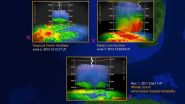INFORMATION:
Funding from the NIH/National Cancer Institute (grants CA140158, CA101140, CA180861), Brigham and Women's Hospital, the Coleman Leukemia Research Foundation, the Pelotonia Fellowship Program, the Associazione Italiana Ricerca sul Cancro AIRC, and Ministero della Istruzione Università e Ricerca supported this research.
Other researchers involved in this study were Dimitrios Papaioannou, Pearlly Yan, Krzysztof Mrózek, Donna Bucci, Ann-Kathrin Eisfeld, James S. Blachly, William Blum, Michael A. Caligiuri, Guido Marcucci, Carlo M. Croce and John C. Byrd of The Ohio State University; Deedra Nicolet and Jessica Kohlschmidt, The Ohio State University and Alliance for Clinical Trials in Oncology Statistics and Data Center, Mayo Clinic; Stefano Volinia, University of Ferrara, Italy; Andrew J. Carroll, University of Alabama at Birmingham; Maria R. Baer, University of Maryland; Meir Wetzler, Roswell Park Cancer Institute; Thomas H. Carter, University of Iowa; Bayard L. Powell, The Comprehensive Cancer Center of Wake Forest University; Jonathan E. Kolitzi, North Shore Cancer Institute; Joseph O. Moore, Duke University and Durham VA Medical Centers, Richard M. Stone, Dana-Farber Cancer Institute.
The Ohio State University Comprehensive Cancer Center - Arthur G. James Cancer Hospital and Richard J. Solove Research Institute strives to create a cancer-free world by integrating scientific research with excellence in education and patient-centered care, a strategy that leads to better methods of prevention, detection and treatment. Ohio State is one of only 41 National Cancer Institute (NCI)-designated Comprehensive Cancer Centers and one of only four centers funded by the NCI to conduct both phase I and phase II clinical trials. The NCI recently rated Ohio State's cancer program as "exceptional," the highest rating given by NCI survey teams. As the cancer program's 306-bed adult patient-care component, The James is a "Top Hospital" as named by the Leapfrog Group and one of the top cancer hospitals in the nation as ranked by U.S. News & World Report.
Long noncoding RNAs: A novel prognostic marker in older patients with acute leukemia
2014-12-15
(Press-News.org) COLUMBUS, Ohio - A new study led by researchers at The Ohio State University Comprehensive Cancer Center - Arthur G. James Cancer Hospital and Richard J. Solove Research Institute (OSUCCC - James) describes a novel marker that might help doctors choose the least toxic, most effective treatment for many older patients with acute myeloid leukemia (AML). AML occurs mainly in older patients and has a three-year survival rate of 5 to 15 percent.
The researchers investigated patterns of molecules called long noncoding RNAs (lncRNAs), a class of RNA molecules more than 200 nucleotide units long that are involved in regulating genes. The researchers examined the abundance, or expression, of lncRNAs in patients who were 60 years and older and who had cytogenetically normal (CN) AML.
The study is published online in the Proceedings of the National Academy of Sciences.
"We have identified a pattern of 48 lncRNAs that predicted both response to standard chemotherapy and overall survival in older CN-AML patients," says first author Ramiro Garzon, MD, associate professor of internal medicine at Ohio State.
"Patients in the favorable group had a high probability of responding to standard chemotherapy, while those in the unfavorable group generally responded poorly to the treatment and had worse overall survival," he says.
These findings are important for several reasons, says principal investigator Clara D. Bloomfield, MD, Distinguished University Professor, Ohio State University Cancer Scholar and holder of the William Greenville Pace III Endowed Chair in Cancer Research.
"First, they strongly suggest that lncRNA expression profiles can predict which patients will respond to standard therapy. That's important because it would spare these patients from the toxic side effects of experimental therapies.
"Patients who are classified in the unfavorable group would receive different therapy, stem cell transplant or a clinical trial using new therapeutic approaches. Thus, this research will help to tailor leukemia therapy to each individual."
In addition, she says, this study identified many novel targets for the development of new therapies.
Garzon, Bloomfield and their colleagues developed the prognostic scoring system using bone-marrow samples from 148 older patients with CN-AML treated on Cancer and Leukemia Group B clinical trials. All had received similar chemotherapy regimens.
The researchers first identified 48 lncRNAs that were most associated with survival. Using these 48 lncRNAs, the researchers divided patients into two groups, those with a favorable outcome score and those with an unfavorable outcome score. The researchers then validated the outcome scores in an independent matched set of 71 similarly treated CN-AML patients.
Comparing patients with an unfavorable score to those with a favorable score revealed the following:
Patients with an unfavorable score had a lower complete response (CR) rate (54 percent vs 89 percent respectively);
Three years after CR, only 7 percent of patients with an unfavorable score were disease free compared with 39 percent of patients with a favorable score.
Overall survival at three years for those with an unfavorable score was 10 percent versus 43 percent for patients with a favorable score.
Distinct lncRNA profiles were associated with six clinically important CN-AML mutations.
In summary, the researchers showed that lncRNA expression profiles were associated with recurrent mutations, clinical features, and outcome in AML. A fraction of these lncRNAs may have a functional role in leukemogenesis. Furthermore, lncRNAs could be used as biomarkers for outcome in AML.
ELSE PRESS RELEASES FROM THIS DATE:
Major milestones for Carnegie-hosted Deep Carbon Observatory
2014-12-15
Washington, D.C.-- Recent advances in our understanding of the quantities, movements, forms and origin of carbon in Earth are summarized in a just-published report. The research represents face-paced progress on the depths of the biosphere, Earth, what erupts from volcanoes and leaks from sea floors, what descends back into Earth's great depths, and the nature of carbon-bearing materials within planets.
The Carnegie Institution for Science is the institutional home of the DCO Secretariat. Carnegie's Robert Hazen and Russell Hemley are the executive and co-executive directors ...
Dental plaque reveals key plant in prehistoric Easter Island diet
2014-12-15
A University of Otago, New Zealand, PhD student analysing dental calculus (hardened plaque) from ancient teeth is helping resolve the question of what plant foods Easter Islanders relied on before European contact.
Known to its Polynesian inhabitants as Rapa Nui, Easter Island is thought to have been colonized around the 13th Century and is famed for its mysterious large stone statues or moai.
Otago Anatomy PhD student Monica Tromp and Idaho State University's Dr John Dudgeon have just published new research clearing up their previous puzzling finding that suggested ...
Rekindling marriage after combat deployment
2014-12-15
A new study offers strategies for rekindling marriage after a spouse returns home from combat with post-traumatic stress symptoms present in one or both of the spouses.
For participants as individuals, it's important to allow negative emotions, to give each other time and space to do the work of rediscovery and accept a changed reality, and to recognize and address the individual needs of the other. As couples, strategies include going with the flow, opening your heart, becoming best friends, maintaining trust, and communicating effectively. As families, it's helpful ...
Edmontosaurus regalis and the Danek Bonebed featured in special issue of CJES
2014-12-15
An exciting new special issue of the Canadian Journal of Earth Sciences shines the spotlight on the Danek Bonebed in Edmonton, Alberta and increases our knowledge of Edmonton's urban dinosaurs, especially the iconic hadrosaurid Edmontosaurus.
Well-preserved, articulated dinosaur specimens often receive much attention from scientists and the public, but bonebeds provide a great deal of information that even the most spectacular articulated specimens cannot. Because of the amount of fossil material, the quality of preservation, ease of preparation, and volume of associated ...
Making sense through order
2014-12-15
"Most researchers have treated the order in which the information is shown as a nuisance that can bias the interpretation of data," said Ting Qian, lead author and a former graduate student in brain and cognitive sciences at the University of Rochester. But as Qian's co-author and thesis advisor, Professor Richard Aslin explained, "We see it as a part of the natural statistics of the real world, and therefore a signal--or cue--that can be the basis of rational decisions."
In a paper published in the journal Proceedings of the National Academy of Sciences, Qian and Aslin ...
Cake or carrots? Timing may decide what you'll nosh on
2014-12-15
VIDEO:
Caltech neuroeconomists have found that your ability to exercise self-control when deciding what to eat may depend upon just how quickly your brain factors healthfulness into a decision.
Click here for more information.
When you open the refrigerator for a late-night snack, are you more likely to grab a slice of chocolate cake or a bag of carrot sticks? Your ability to exercise self-control--i.e., to settle for the carrots--may depend upon just how quickly your brain factors ...
New study reveals Montmorency tart cherry juice accelerated recovery after intense cycling
2014-12-15
LANSING, Mich. December 15, 2014 - Cyclists who are preparing for race day may have a new sports drink to give them an edge in recovery: tart cherry juice. A new study published in Applied Physiology, Nutrition, and Metabolism found that Montmorency tart cherry juice helped accelerate recovery, maintain muscle function and reduce certain markers of exercise-induced inflammation among a group of cyclists participating in a simulated road race.
The research team, led by Glyn Howatson and Phillip G. Bell at Northumbria University in the U.K., conducted this double-blind, ...
NASA's Fermi Mission brings deeper focus to thunderstorm gamma-rays
2014-12-15
Each day, thunderstorms around the world produce about a thousand quick bursts of gamma rays, some of the highest-energy light naturally found on Earth. By merging records of events seen by NASA's Fermi Gamma-ray Space Telescope with data from ground-based radar and lightning detectors, scientists have completed the most detailed analysis to date of the types of thunderstorms involved.
"Remarkably, we have found that any thunderstorm can produce gamma rays, even those that appear to be so weak a meteorologist wouldn't look twice at them," said Themis Chronis, who led ...
Do carrots actually help you see better? (video)
2014-12-15
WASHINGTON, Dec. 15, 2014 -- It's something your mother told you time and time again at the dinner table: "Eat your carrots, they'll help you see better!" So was she right? This week, Reactions answers the question with the help of chemist Chad Jones, Ph.D., host of the award-winning Collapsed Wave Function podcast. Check out the video here: https://www.youtube.com/watch?v=w3DNScZYvYY.
Subscribe to the series at Reactions YouTube, and follow us on Twitter @ACSreactions to be the first to see our latest videos.
INFORMATION:The American Chemical Society is a nonprofit ...
Research finds copyright confusion has 'chilling effects' in online creative publishing
2014-12-15
Online content creation has become easier than ever and is quickly reaching parity with content consumption. From writing a blog or social media post to letting an app turn your photos into a video montage, anyone with an Internet connection can publish these creations with the click of a button.
But in the age of Web publishing, it has become increasingly confusing for content creators to figure out how to protect their original works or to use other content legally -- such as for remixes or parodies -- on major websites for user-generated content, including YouTube ...




